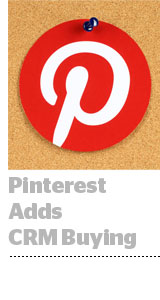 Marketers can now target advertising on Pinterest using their CRM lists or mobile ad IDs, and expand those campaigns through lookalike targeting.
Marketers can now target advertising on Pinterest using their CRM lists or mobile ad IDs, and expand those campaigns through lookalike targeting.
The product update gives marketers a way to reach their existing customers, a la Facebook’s popular Custom Audiences product.
“This is becoming a must-have in the marketplace because of the performance it drives,” said Pinterest product manager Frank Fumarola. “Marketers have seen the success, and there is a level of comfort sharing data with platforms.”
Advertisers can find their customers on Pinterest using email addresses or mobile ad IDs, where match rates can be slightly higher. The latter may be especially appealing to partners with mobile apps. Via lookalike targeting, advertisers can expand the reach of their ad buys. Marketers can also onboard their data using LiveRamp or Epsilon if they choose.
Pinterest had previously limited customer-targeting functionalities. Marketers using a Pinterest preferred marketing partner could target using hashed email addresses. But that option left out marketers large and small.
Some advertisers might be more comfortable sharing data with a platform directly, for example, rather than a third-party vendor. Meanwhile smaller advertisers might not be familiar with the hashing process.
Pinterest has been testing this targeting option since February. Lookalike targeting increased click-through rates up to 63%, according to Pinterest, and increased reach up to 30 times.
Pinterest also has added the ability for marketers to retarget customers who have visited the marketer’s site up to 540 days prior. Retargeting those customers on Pinterest increased click-through rates by a factor of three.
Like Facebook Custom Audience, Pinterest’s support for first-party data operates on walled garden principles. It’s hard to get performance data for ads served to customers back out of the platform. “We believe that partners getting those performance improvements is a good value exchange,” Fumarola said.
Match rates align with industry averages, Fumarola said, which can range from 30% to 70%.
Of those customers who match, though, will marketers find them active on Pinterest during the timeline they need for a campaign? It depends on the answer to this question: “How much does your audience overlap with Pinterest user base?” Fumarola said.
Pinterest claims 100 million monthly active users. Half of those live in the United States. As long as advertisers have enough active pinners among their customers, they should be able to reap the benefits of CRM targeting.
While the CRM-matched audience pools marketers find on Pinterest may be smaller than Facebook’s, marketers are likely to respond if only out of a desperate wish for alternatives (a desire that also underpins Merkle’s recent CRM targeting initiative).
Pinterest isn’t done with helping marketers engage with prospective or existing customers. A logical next step is to allow marketers to reach users who have engaged with a brand’s pins but never clicked through to the site, Fumarola said. Those users could receive sequential or follow-up messaging designed to get them to convert.














